Claim
More wildlife crime took place during Covid-19 restrictions in 2020.
What the science says
Partially correct.
Due to the nature of wildlife crime, and the efforts of criminals to hide evidence of their wrongdoing, accurate data is often difficult to come by. However, it appears that levels of wildlife crime were affected by the worst of the pandemic in 2020.
Unfortunately, there is simply not enough data available for amphibians and reptiles, poaching of hare and deer, or marine mammal disturbance to say one way or another if more crime took place in 2020 in the UK, even if anecdotal or regional reports say otherwise. It seems that bat crimes and wildlife trade were largely limited by the pandemic and restrictions that followed, but dramatic increases in the number of reports suggest that rates of fisheries and raptor crimes were higher throughout 2020 – with criminals using restrictions to commit crimes seemingly unnoticed. Badger crimes, however, seems to be a perfect example of the ‘lockdown effect’, with expert opinion and data suggesting that there was both an increase in crime and an increase in reporting in 2020.
Wildlife crime is a complicated subject, and both the type and availability of information varies greatly depending on what kind of crime is being discussed and how equipped local police and NGOs are to deal with it, but it seems clear that for some wildlife groups, there was more crime in 2020.
Where the claim came from
The claim that wildlife crime reports increased throughout Covid-19 lockdowns in 2020 has been made by multiple sources such as National Geographic1, The Guardian2 and other news outlets3,4, as well as by police forces5, police newsletters6, and organisations such as the Badger Trust7.
Many of these articles reference the recently published Wildlife Crime in 2020 Report8 by Wildlife and Countryside Link, which reviews reported wildlife crime throughout 2020.
What the science says – the fuller picture
Wildlife crime can take many forms and can include everything from picking a rare flower to killing protected or endangered wildlife. Broadly, criminal offences in the UK include the following9,10:
- Killing or disturbing protected species
- Taking protected species from the wild
- Damaging the breeding and resting places of protected species
- Illegally trading in protected species
- Illegally introducing or releasing invasive non-native species
- Causing animals unnecessary pain and suffering
Although wildlife crime is a global problem and can take place on an international level, there are specific crimes that are a priority to the National Wildlife Crime Unit in the UK. These include badger, bat, and raptor persecution; illegal trade of European eel, raptors, ivory, medicinal products, reptiles, rhino horn, and timber; poaching of deer and fish; hare coursing; illegal harvest of freshwater pearl mussels; and cyber-enabled wildlife crime11.
Across the UK most wildlife crimes are punishable with a fine and/or short custodial sentence, this can be up to five years in Scotland12. The largest fine issued to a wildlife crime offender in the UK was £600,000 in 2020 following destruction of a bat roost13.
Issues with wildlife crime data
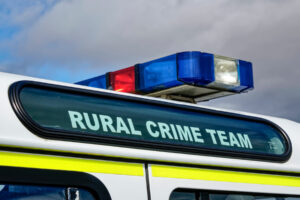
The UK has a long history of successfully reporting on crime and prosecution trends, but at present wildlife crimes are not ‘notifiable’, meaning that records are not centrally kept by the government8,12. In England and Wales there is no obligation for the government to report on wildlife crime, whereas the Scottish government has been annually reporting on it since 201114.
Sometimes there are inconsistencies in how wildlife crimes are dealt with by different police forces, with forces around the country being largely unable to judge how much wildlife crime is taking place8. This is due to things such as:
- Variation in resources to deal with crime reports and keep full records of proceedings8
- Uncertainty about what kind of evidence is needed14 and what counts as admissible evidence8
- Difficulty in securing ‘expert witnesses’ to assist with police and court proceedings8
- Some incidents failing to be accepted as police matters, potentially labelled as ‘RSPCA matters’ or closed, in which case evidence often fails to be collected15,16
- Incidents being mislabelled as antisocial behaviour events when initially being reported to the police17
Due to these police limitations, wildlife crime data often exists in each stage of the criminal justice system, but in a scattered, inconsistent way. This makes it difficult to track cases through the system and means that spotting trends in wildlife crime is a challenge12. A lot of the data in England and Wales comes from non-governmental organisations (NGOs) – for example the Bat Conservation Trust. While records may be kept within each organisation, there are often differences in how crimes are recorded and this can change over time, making data difficult to compare15,17. There is also a large bias in the kind of information that is available, with a lack of data available about marine, plant, and forestry related offences12. Often the number of reports recorded by NGOs and the police differs18.
These inconsistencies and data gaps ultimately mean that the true extent of wildlife crime cannot be judged from official statistics8,12,19. As a result, it is important to interpret data as the minimum number of incidents taking place15,17.
Potential impacts of Covid-19 on data and crime rates
Crime rates varied greatly between different places and types of crime throughout Covid-19 lockdowns and restrictions20, suggesting that the effects of the pandemic on crime were not universal21. From the data available it seems that while offences like drug use increased, theft and assault rates dropped significantly21, but how does this translate to wildlife crime?
The Office for National Statistics 2021 crime report notes that patterns of crime “have been significantly affected by the COVID pandemic”22 and this appears to be reflected in UK wildlife crimes, with sharp rises in reports and confirmed cases for badger, fisheries, and bird of prey related offences in particular8. In Scotland alone, there were 105 more wildlife crime reports in 2020 compared to 2019, with a 41% increase in reports compared to the previous five-year average23.
This could be due to what has been called the ‘lockdown effect’, a phenomenon that links increased reports of wildlife crime to two factors7,8,23:
- People were out in the countryside more than usual, and so more people were able to spot and report crimes
- There was a perception that the police were busy enforcing lockdown, and so crimes could take place unnoticed
The reality is likely to be a combination of factors resulting in both more reports, and more crimes. Throughout Covid-19 restrictions and lockdowns, staff from the police, courts, and organisations such as the RSPCA faced difficulties in continuing work as normal. This will likely have fed into perceptions that they were focused ‘elsewhere’ and have had an impact on actions taken against wildlife crimes8.
It is also important to note that because of the pandemic, there is a large case backlog in courts and so some data are not available yet20. There was a large drop in prosecutions for lots of types of wildlife crime in 2020, which is likely to be the result of the additional pressures on the police and the backlog facing the Crown Prosecution Service8.
Amphibians and reptiles
Amphibians and reptiles often do not come to mind when we think of wildlife crime, but the UK is home to 13 native species that have legal protection against intentional injury and killing, capture from the wild, and unregulated trade24. Some species and their habitats have a higher degree of protection from disturbance and damage8,14.
These animals fall victim to a range of crimes, but mainly suffer from persecution and habitat loss due to management or development taking place without appropriate ecological surveys and mitigation8. Deliberate killings often come from a place of fear stemming from misconceptions that they pose risks to people, pets and livestock – this is usually associated with adders though they present very little risk. There also appears to be a belief that there is a low risk of being prosecuted for offences, and that penalties will cost less than the lawful process of ecological surveys18.
Despite reptiles and amphibians being protected and subject to very real threats, neither the government nor the police appear able to report on the level of crime affecting them18. Wildlife crime officers suggest that they deal with more allegations involving great crested newts than they do for bats25, but there isn’t much information available about the number of reports made to police, how they are dealt with, or what any potential outcomes are18. It is also highly likely that many allegations go unreported8.
In recent years there have been various allegations of snakes being deliberately killed in 201718 and 20208,26, and in 2018 a man was convicted and fined a total of £1,405 following the destruction of protected newt habitat18. There appear to have been lots of allegations reported to the Amphibian and Reptile Conservation Trust through the ‘Bearing Witness for Wildlife’ project throughout 2020. These reports related to ongoing development works, habitat pollution and damage, and reptiles being found dead – but formal data are not available.
As a result, it is difficult to know if crime levels where higher in 2020 when Covid-19 restrictions were in place. There appears to be a downwards trend in reported incidents and cases referred to the police in 2017-2019 (figure 1), but without numerical data for 2020 this cannot be explored further. There have been few convictions over the last five years, and no known prosecutions related to amphibians or reptiles in 20208. This is despite six cases in 2017 and one case in 2019 where criminal offending was confirmed and is likely the result of insufficient evidence14,16.
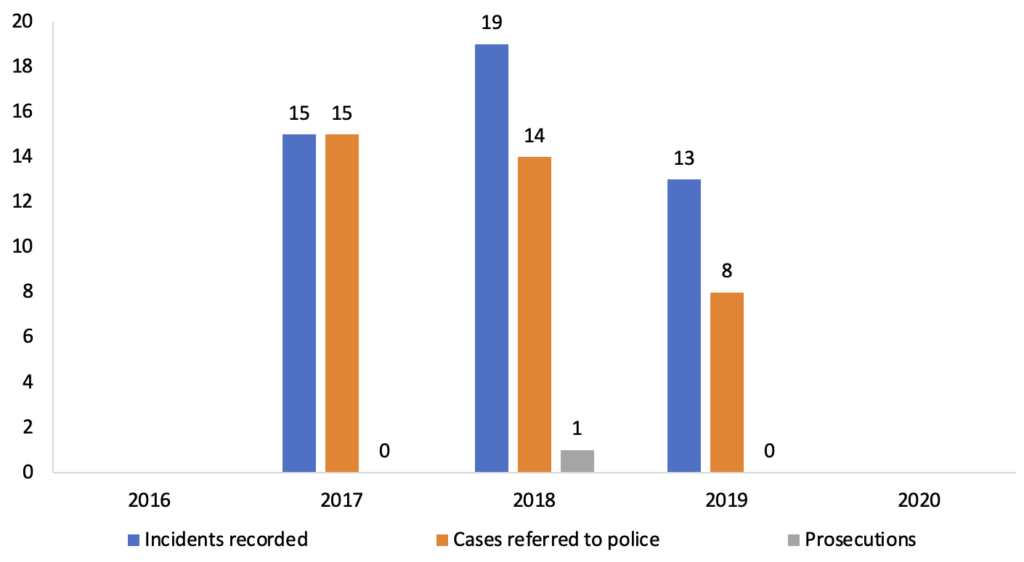
Badgers
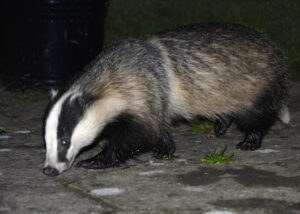
Badgers are well-known characters in the British countryside, and both the animals and their setts are protected under UK and European laws such as the Wildlife and Countryside Act 1981 and the Protection of Badgers Act 19928,15. Despite having one of the highest levels of legal protection, badgers are one of the most demonised species in the UK27 and are subject to crimes such as sett interference, badger baiting, shooting, snaring, trapping, poisoning, and hunting with dogs8.
Many of these crimes are extremely cruel and cause a great amount of suffering9, and offenders are known from a wide range of backgrounds – involved in everything from agriculture and forestry to development, and even including ordinary homeowners8. Because of this widespread persecution, badger-related offences have been a UK Wildlife Crime Priority since 2009 and were recently featured in the 2018-2021 NPCC Wildlife Crime Policing Strategy8,16,18. It is difficult to judge how widespread legal culling efforts to eradicate bovine Tb since 2013 may have impacted public perception of the animals8,16. As a result, we can only really speculate on whether it has legitimised more persecution, lead to more reporting of persecution, or a mixture of both.
The number of reports made to the Badger Trust and police in England and Wales from 2011-2019 has been reasonably high at an average of 547 reports a year, with many of these reports and resulting prosecutions related to badger baiting and sett interference8,14-16,18. Despite a decline in reports from 2017 (figure 2), the number of prosecutions has increased significantly over the last five years, which could be due to police training provided by the Badger Trust since 20178,27.
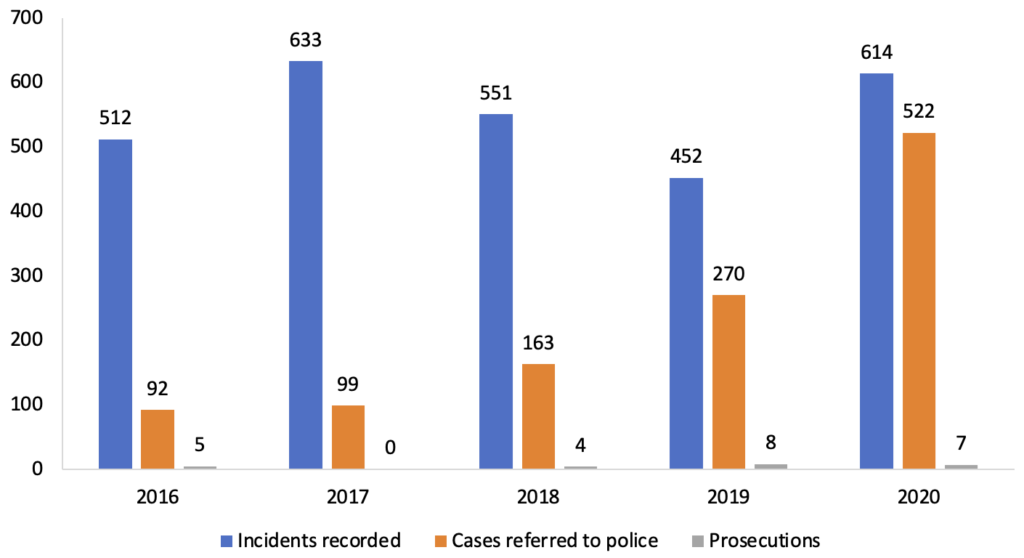
Crime reports increased by 36% (162 reports) between 2019 and 2020, putting the number of incidents reported in 2020 well above the average for the previous four years8. If comparing data presented in the 2016-2019 wildlife crime reports14-16,18, it seems that the number of incidents reported across this period suddenly decreased without explanation. We contacted the Wildlife and Countryside Link and have been able to clarify that this is because of what is called data cleaning, where for example, duplicated reports are identified and removed28. Where previously it would have appeared that reports only increased by 3% (16 reports) in 2020, this data cleaning provides a much more accurate picture and signals that there was actually a 36% increase in crime reports8.
While you cannot tell from the numbers alone, reports of sett interference within badger culling zones have increased8. This suggests that the introduction of cull zones may have locally raised the profile of badgers and resulted in more people reporting incidents where they might have gone previously unnoticed8,14. It is thought that the ‘lockdown effect’ may have also had an impact on the number of incidents reported in 20207,8, and so it is difficult to know if more incidents took place, or if more people were reporting potential crimes. At the very least, we know that during lockdown there was over a 220% increase in reports concerning development8, which supports the idea that more people were making reports throughout lockdowns.
The Badger Trust launched a short film and campaign in 2020 to raise awareness on badger crime and how to spot it to try to increase reporting, working with local badger groups to achieve this. The charity believes this contributed to an increase in crime reports7. Given that the data represents a 36% increase in reported incidents in England and Wales, it is probable that some of this increase was due to increased reporting by the public. Without any more insight into the data, it is difficult to know whether more crime took place or if increased reporting is simply revealing the true scale of badger crime.
Bats
There are 17 species of bat resident in the UK29, and all are protected against killing, injury, harm, and disturbance. Their breeding and roosting places are also protected from damage and destruction even when bats are not present8,30. Crimes against bats are often related to development or maintenance of properties, disturbance of bat roosts, and unlawful felling or management of trees15. There is also usually a peak in offences between June and August, which coincides with when bats are breeding in what are called maternity roosts and can have big impacts on populations8.
Because of efforts from the police, Bat Conservation Trust (BCT) volunteers, and ecologists, many potential offences are prevented through early intervention and advice8,16. This can make a big difference to case numbers, as lots of offences are the result of people failing to plan for bat surveys and obtain the licences needed. That said, some cases are planned and deliberate14.
Of the reports made to the police and the BCT, very few result in prosecution (figure 3). This could be due to a number of factors, such as gaps in police training and/or resources15, but there are also a number of cases where a crime has been confirmed and evidenced, but the police have no information that could lead them to an offender18. Many cases do not make it into a courtroom because offenders plead guilty at the first opportunity and accept financial sanctions15. In cases like this, fines often centre around some level of ‘restorative justice’ to bring about conservation benefit for bats15,31.
The size of financial sanctions imposed on offenders varies greatly; in 2017 two men were fined a total of £401 in Leamington Spa Court after they knowingly destroyed a bat roost, which was roughly 25% of their declared weekly income despite the law allowing for unlimited fines32. A year later the Crown Prosecution Service fined a property developer £20,000 for destroying three bat roosts18.
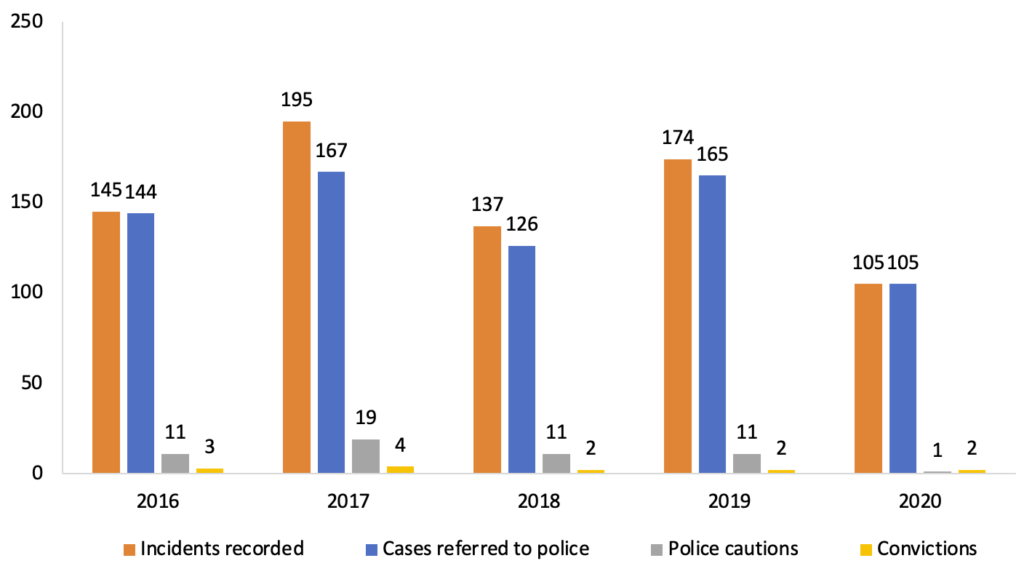
In 2020 there was a distinct drop in incidents reported to the BCT, with a 49% decrease compared to 20198,16. Half of these reports related to damage or destruction of bat roosts, and 20% related to disturbance of bat roosts8. Between 2010 and 2019, there was an average of 145 reports and two to four prosecutions a year8,17,33, and while the number of prosecutions has remained largely the same despite Covid-19, the number of police cautions and incident reports is well below average. That said, one of the convictions involved the highest fine ever given for a wildlife crime in the UK, with a housing developer fined £600,000 following bat roost destruction8,31.
While it is difficult to answer why fewer reports were made in 2020 throughout lockdowns and other Covid-19 restrictions, a big factor was likely to have been that there were fewer building works going on, and so fewer opportunities for roosts to be disturbed. Covid-19 has had a large impact on the construction industry, resulting in staff losses, cash flow issues, and site delays – plus delays with contractors and acquiring materials34, all of which resulted in lots of works being postponed. Another important consideration is that because of Covid-19, fewer police officers, volunteers and ecologists would have been able to visit soon-to-be building sites and give advice or cautions to potential offenders.
Fisheries
Fisheries crimes can take many forms, being as seemingly minor as fishing without the appropriate rod licence, to illegally catching marine and endangered fish to sell for profit8. Common crimes include the illegal import and export of some kinds of fish such as carp; theft of fish from commercial sport fisheries; illegal capture of fish for food; unlawful capture of sea fish; netting salmon for profit; and illegal trafficking of infant eels (elver)8,14. Fisheries crimes are financially quantifiable and often linked to wider, organised crime18 and can be related to other crimes such as the illegal dumping of waste and trapping of otters8.
In the UK, freshwater fisheries are overseen by the Environment Agency, Angling Trust, and Fisheries Enforcement Support Service14; whereas marine and seawater fisheries are overseen by a network of Inshore Fisheries & Conservation Authorities and the Marine Management Organisation, depending on how far from shore the fisheries are8. Some incidents are reported directly to these organisations, but many are also reported to the police – this creates lots of opportunity for inconsistent recording and difficulty in tracking crime reports. It is believed that some fisheries theft offences go unreported because of a lack of confidence that something will be done14.
Between 2016 and 2019 there has been a general decline in the number of incidents reported to authority bodies and the police (figure 4), this is likely because less people have been engaging in angling in recent years8,16. That said, the number of incidents passed onto the police has been fairly consistent over the last five years, as has the number of convictions – with 75% of people between 2016-2019 convicted when a criminal offence has been confirmed8,16.
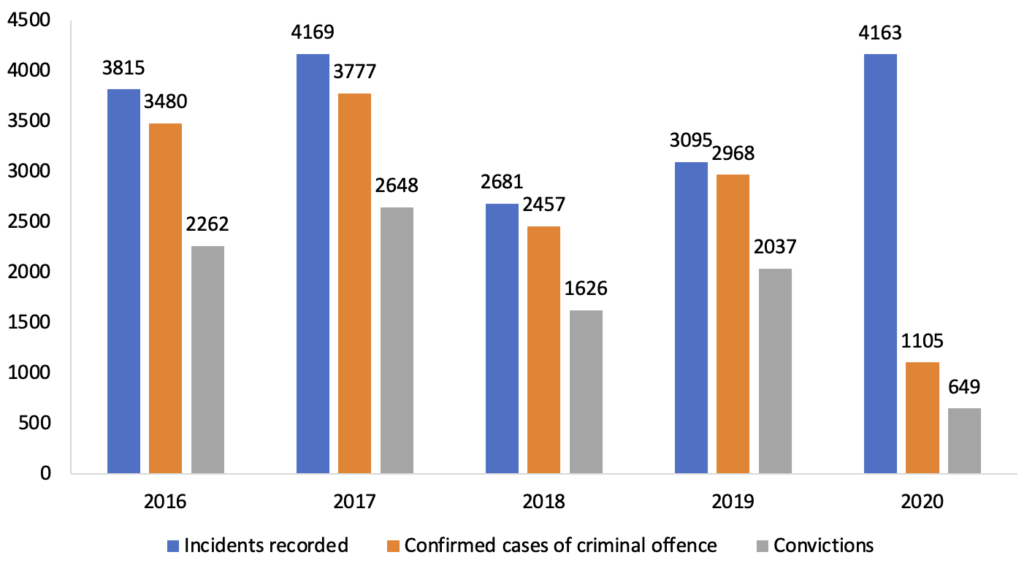
It is believed that Covid-19 restrictions had a big impact on fisheries crimes as law enforcement staff were less able to detect and report crime, and prosecutions reduced as fewer courts were in full operation8. That said, the Environment Agency’s Voluntary Bailiff Service still managed to complete 11,604 waterway patrols in 2020, which is only 1,884 fewer than the number completed in 20198,16. This means that, although the number of patrols were slightly reduced due to Covid-19 restrictions, the number of reports was well above that of 2019 and was 723 reports higher than the 2016-2019 average8.
The number of confirmed cases of criminal offence in 2020 was almost a third of the previous four-year average, and this could be the result of fewer resources available to collect evidence, or because fewer people were outdoors and able to witness crimes taking place. The number of convictions is also significantly lower than previous years – but it is important to note that because of the pandemic there is a large case backlog in courts and so some data may not available yet20. The fact that the number of reports was so high in 2020 is noteworthy, as it suggests that there may have been more crime taking place while restrictions were in place, since fewer patrols make it unlikely that reporting rates increased. Given that fisheries crimes can be very financially profitable – trafficking of endangered European eels alone was worth £3 billion in 20178 and salmon and sea trout remain highly prized for meat16 – it appears likely that criminals may have taken the opportunity that Covid-19 restriction presented to commit crimes undetected.
Poaching
Illegal hunting, or poaching, is a politically charged issue in the UK12, and while there are several pieces of legislation banning and controlling hunting – including several pieces that are specific to some animals, e.g., the Deer Act 1991 – it can involve a wide range of species such as fish, deer, hares, otters, badgers, foxes and mink8,16 and have large ecological and economic impacts on the environment and rural communities35. Poaching is commonly linked to other types of crime such as theft, illegal possession of firearms, criminal damage, assault, animal cruelty, and illegal betting35,36.
There are legal exceptions for some kinds of hunting that place limits on what can be hunted, when, and how12,36, however there is consistent evidence that the hunting of foxes, hare, and red deer continues in many areas despite legislation and almost two decades of the Hunting Act 20048,16. This can lead to difficulties in policing illegal poaching if police are not trained to know the difference between what is legal and what is not12. Figure 5 shows Ministry of Justice data on the cases processed under the Hunting Act 2004, showing a relatively consistent number of prosecutions and convictions of crimes related to illegal hunting between 2007 and 2015, with a slight reduction during 2016-20208.
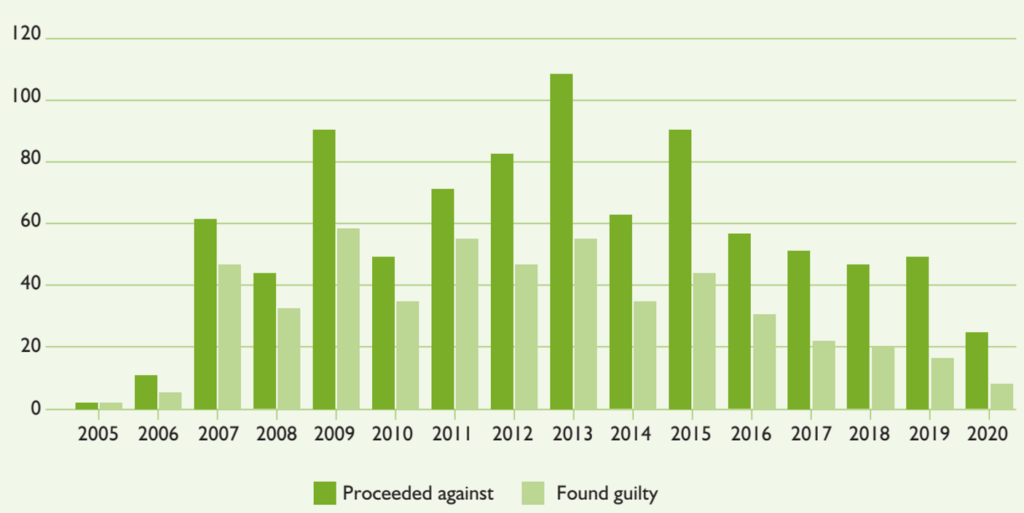
Deer poaching is an area of particular concern and regularly receives media attention37-43. While the hunting of deer is permitted at certain times of the year, depending on the species, during the daytime, and if you have permission from the landowner – poaching involves illegal trespassing and night-time shooting9,36. Poaching can be lucrative, with some criminals hiding behind legal trade of venison and illegally selling the meat to pubs and restaurants in times of high demand, often for large amounts of money41,44,45.
The British Deer Society estimates that as many as 50,000 deer are killed annually by poachers across the UK and that poaching is likely under-reported46. This could be because of intimidation of local communities by criminals; because poaching takes place at a time when few people are around to witness it; or because the animal (and so evidence) is removed47. Although this does not appear to be supported by evidence, with only 1,147 incidents reported to police between 2008 and 2011 according to the National Wildlife Crime Unit. The majority of these reports were made in England48. Despite being a wildlife crime priority, there is surprisingly little data relating to deer poaching, and as such no commentary can be made on trends or if more poaching took place throughout Covid-19 restrictions – although rises in demand for venison in pubs and restaurants following the end of lockdown may have led to increased poaching in some areas.
Hare coursing is another form of poaching and is also a wildlife crime priority in the UK, but continues despite being banned under UK law8. It is an illegal sport that involves the use of dogs to catch and kill hares and is often linked with other serious crimes such as theft, criminal damage, violence, drug dealing, and gambling – where criminals can make thousands of pounds from betting on the sport online35,49,50. Hare coursing has also been linked to organised crime8,51 and criminals are known to travel hundreds of miles to chase and capture hares8,52.
Coursing mostly takes place in remote locations and happens in a very short amount of time, making it difficult to collect evidence. This is made worse by the fact that potential witnesses are often threatened and so do not come forward; much of the organisation takes place via social media and the internet; and the police often lack the training necessary to determine what should be recorded as a hare coursing incident – meaning that under-recording is very likely16. In fact, 23 out of 35 police forces could not provide any detail on hare coursing when asked, despite knowing it takes place in their area. Of the incidents reported, even fewer reach prosecution, which is often the result of insufficient evidence or an inability to identify any suspects16.
This general lack of information relating to hare coursing is problematic and prevents us from drawing any real conclusions about the rates of crime through lockdown or even in previous years, but data from Lincolnshire can give us an insight. Lincolnshire has a good hare population, and so has reasonably high levels of hare coursing. Between 2017 and 2019 local police focused their efforts on prevention, and over this time there was a decline in incidence reports (Figure 6) – but the number of reports increased by almost 200 reports in 2019-202016. While these figures run September 2019 to March 2020 and are likely to be an underestimation of the true extent of hare coursing in the county, the fact that reports were on the increase may signal that offenders were on track to carry out more crimes during Covid-19 restrictions, given that an increase in reporting is unlikely due to the nature of hare coursing. Without any more data from across the country or throughout 2020, however, this is cannot be asserted with confidence.
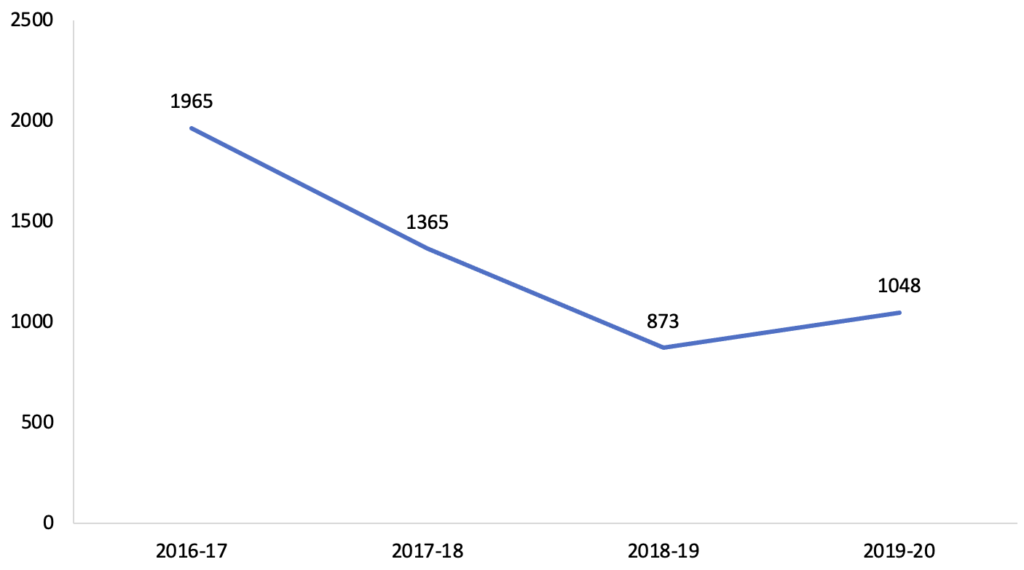
Illegal wildlife trade
The illegal wildlife trade is a global problem and is thought to be worth up to $23 billion a year53, with 2018 estimates placed at £10-20 billion a year19,54. It is thought to impact over 7,000 species worldwide14 and while there is $323 billion worth of legal wildlife trade annually, it is almost impossible to know the true extent and worth of illegal trade55. The UK acts as both a destination and a source country for illegal trade, with social media and auction websites acting as platforms for illegal imports, exports and sales to pose as legal business8,14.
Illegal trade can involve a wide range of live specimens or wildlife products, with common areas of crime including8,14:
- Demand for species like tortoises, owls, and primates desired as pets
- Trafficking of European eels sent abroad for food
- Demand for mounted or pinned animals, traditional medicines, and ornaments made from ivory
- Tourists bringing home illegal products such as coral or rosewood
- Demand for bushmeat
The National Wildlife Crime Unit has seven priority areas: European eels; illegal trade in raptors; ivory; medicinal and health products; reptiles; rhino horn and timber18. Successful convictions have largely decreased since 20168 but recent cases include the sale of rhino horns, elephant teeth and hippo teeth in 201714; illegal harvesting and sale of timber, and the sale of prohibited taxidermy birds of prey in 201818; import and online sale of python skin accessories, ivory products, and rare birds eggs in 201916; and trafficking of endangered European eels worth £53,265,000 from London to Hong Kong in 20208. Many of these offences involve shipping items internationally using forged paperwork and are largely facilitated by social media and the internet8,16.
The number of convictions has generally declined since 2013 excluding a peak in 2016 (figure 7), which is consistent with other types of domestic wildlife crimes12, although it is not clear why so few prosecutions are taking place. This is concerning given that 2020 saw the lowest number of Convention on International Trade in Endangered Species (CITES) prosecutions in a single year since records have been collected8.
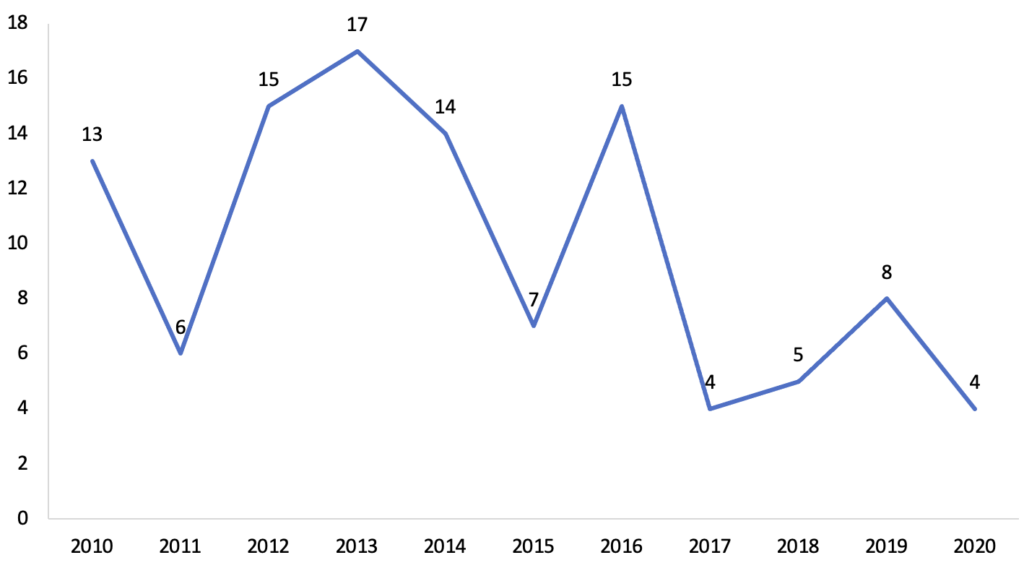
Because of the nature of illegal trade there is generally a lack of data available, with the information available only relating to known prosecutions or the number of seizures made by border forces14. There is also a bias in the types of trade picked up by border forces, with seizures of ivory, live birds and plants, timber, and endangered species products taking place regularly, but trade in invertebrates being under-documented16,56. Some of this is likely the result of which species are listed under the CITES.
A seemingly obvious impact of the pandemic is that less illegal wildlife trade could take place due to restricted international travel57,58, and this appears to be the case based on UK border force seizure records (figure 8). These records show that there was a big decline in seizures in the first half of 2020, supporting the idea that near-global Covid-19 lockdowns disrupted the transport of illegal wildlife products8. However, it seems that while face-to-face crime and physical trade was less frequent, illegal trade continued to be prolific online59. Some evidence suggests that while seizures at borders and transport hubs largely declined, criminals used lockdowns to stockpile items like ivory and pangolin scales in anticipation of high demand once restrictions were lifted58. Records kept by the Home Office show that there was a significant increase in offences in England and Wales in 2021 compared to 2019 and 2020, which could support this idea12.
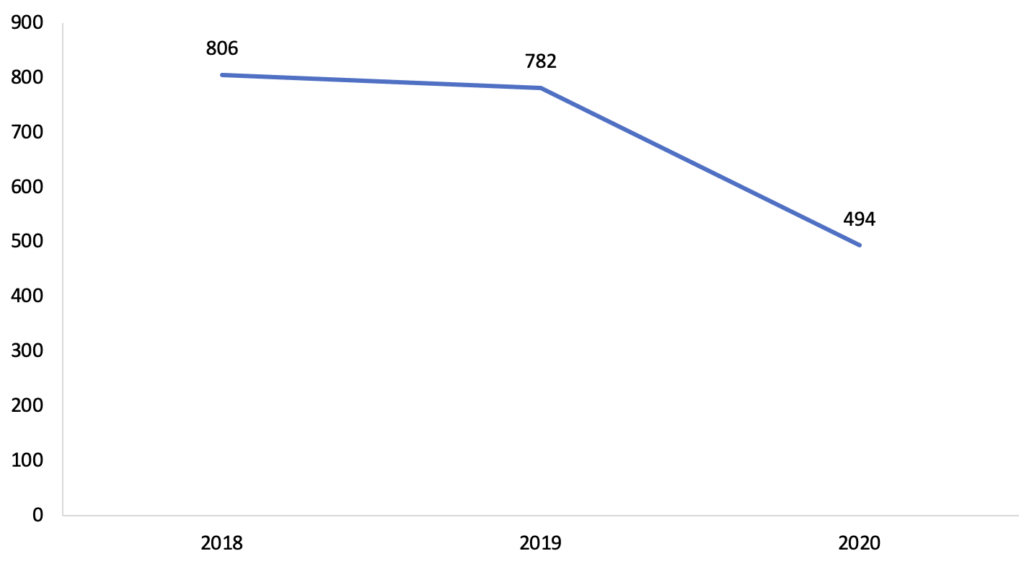
It is also important to understand that illegal trade does not only take place on an international level, with the sale of illegally poached venison and fish within the UK also counting as illegal trade. This was seen in many parts of the world, with some places in Africa and Asia seeing increased bushmeat poaching and logging as there was mass movement from urban to rural areas associated with pandemic-related economic hardship60.
As a result, and with the data available to draw conclusions from, it seems fair to judge that less international trade of illegal wildlife items took place throughout 2020 – mainly limited by restrictions on travel. This not does necessarily mean that less crime took place, particularly if offenders used lockdown periods to increase their ‘stock’ and pre-arrange international sales via the internet. It might also be the case that the restrictions on international travel and trade forced some criminals to shift to domestic trade, for example in illegally poached meats.
Marine mammals
Marine mammals are creatures such as seals, dolphins and whales – with around 27 species found in coastal waters around the UK8,61. These species are offered strict legal protection under European and UK law, making it a crime to deliberately catch, kill or disturb them8,14. Despite that, many commercial and recreational activities negatively affect marine mammals, with common crimes including tourism-related disturbance of animals and cruelty towards seals through injury or killing with guns and other weapons14.
In recent years, various campaigns – such as #RudeToIntrude and the development of coastal codes of conduct – have aimed to improve public awareness and understanding of marine mammals, what counts as disturbance, and how to report incidents8,18. Reports are mostly made by the public to organisation-specific and coastal hotlines, but very few cases are reported to the police – which is likely to be a combination of the public not understanding that marine issues are crimes, and hotline operators potentially not having the necessary training to determine what is and isn’t a police matter14.
As with many other wildlife crimes, incidents involving marine mammals are not centrally recorded and so little data is available on the number of incidents taking place. Disturbance incidents have been recorded in many places around the UK’s coastline and have been recognised as an issue by multiple non-governmental organisations (NGOs), local experts, and researchers62. That said, the bulk of information available is from Cornwall, where the Cornwall Wildlife Trust works with groups such as the Cornwall Marine and Coastal Code Group, Seal Alliance, and WiSe campaign to record incidents and help educate the public about the issue8.
The number of disturbance incidents reported in Cornwall almost tripled between 2014 and 2020 (figure 9), with photographs and videos being regularly shared online of people ignoring signage and fences and approaching marine mammal basking areas, and of people using watercraft to get dangerously close to marine mammals in the water63. Disturbance is such an issue that surveys by the Seal Alliance found that in some parts of Cornwall, seals were disturbed as regularly as every seven minutes by human activity on land and in the water62. Typically, the peak in disturbance reports coincides with peak visitor numbers in Cornwall in August8.
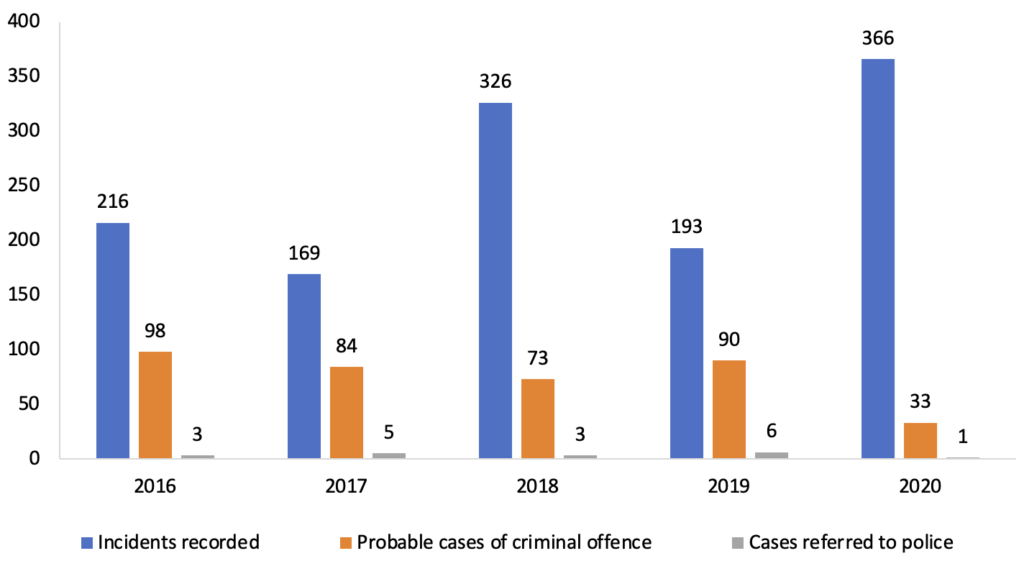
Because of the pandemic, 2020 saw heavy restrictions on international travel, and while it does not appear that more people went on domestic holidays within the UK, the summer of 2020 saw increased demand for countryside and seaside holidays, with tourists urged to stay away from areas such as Bournemouth and Cornwall in June and August 2020 due to overcrowding and safety concerns64. It appears that this demand for seaside holidays and following overcrowding may have amplified the problem in Cornwall, with an 89% increase in incidence reports in 2020 compared to 2019. While we do not have data for other parts of the country to see if this was part of a wider trend of increased disturbance of marine mammals, increased numbers of visitors to the UK’s beaches was a clear trend throughout the summer holidays in 2020 – so the idea that criminal disturbance of marine mammals was more common in 2020 is not unfounded.
Raptors
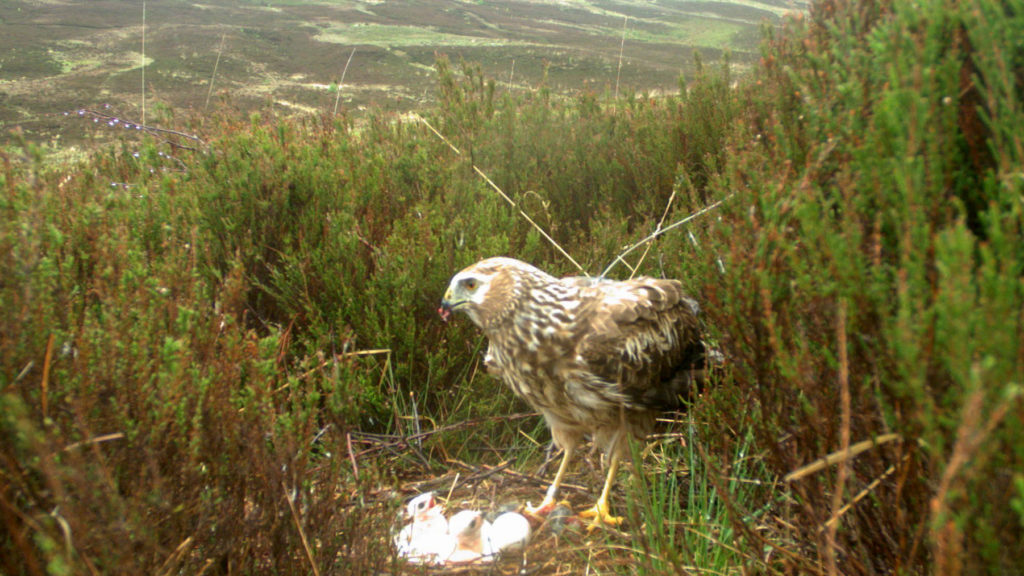
All birds of prey are fully protected by law in the UK, with activities such as killing, taking, or injuring of birds and eggs, and the damage or destruction of nests being a criminal offence14. Birds are often shot or poisoned with concoctions of chemicals such as Carbofuran and Alphachloralose, pesticides made available in poisoned bait – which is illegal in itself1,16. Raptor persecution has been a UK wildlife crime priority since 2009 due to severity and high levels of persecution16,18.
Incidence reports are made directly to the police and to the RSPB and can involve the RSPCA and Natural England if there are animal welfare concerns or poisoning has occurred. Generally, the risk of offenders being caught and later prosecuted is low despite raptor persecution being a priority issue14. This is due to two key factors: the remote locations in which these crimes often take place, and the fact that offenders will go to great lengths to hide or destroy evidence of persecution, even for birds that have been fitted with satellite tags65-67. Anecdotal evidence suggests that some criminals will go as far as wrapping satellite tags in lead sheeting to try to block their signal before disposing of them68.
Several pieces of research, crime data, and police intelligence shows that the biggest – although not the only – driver of raptor persecution is gamebird shooting, with hen harriers and golden eagles being particularly vulnerable8,14. This is a fact that What the Science Says verified in 202069. Over a 30-year period between 1990 and 2020, a total of 186 people are known to have been convicted in relation to raptor persecution1,70 – 65 of these offenders worked as gamekeepers, 10 were taxidermists, 10 were involved in pigeon fancying, and four were related to farming interests8.
Hen harriers are regular victims of raptor persecution in the UK, which is particularly concerning as a government study from 2019 found that illegal killing is the biggest factor suppressing the UK’s hen harrier population8. Between 2007 and 2017 a total of 58 hen harriers were successfully fitted with satellite tags; another two were unsuccessfully fitted with tags. In this time, 42 of them were killed or most likely to have been killed on or in the vicinity of grouse moors. Four birds were found with evidence of being killed, but the remaining 38 disappeared without any sign of tag malfunction and the birds were not seen again8,18,65,71. Between 2018 and 2020, an additional 57 hen harriers have been killed or have gone missing under suspicious circumstances across the UK8,16.
Many these birds disappear without much indication of what happened, but research has shown that satellite tag failure in hen harriers is ten times more likely to occur over grouse moors65 and in Wales raptors are three times more likely to be persecuted around grouse moors8 – so it is worth exploring potential explanations. Studies looking at the effectiveness of satellite tags show that the tags show signs of working abnormally before failing completely, allowing scientists to try to retrieve the tags and at the very least giving them a rough location to try to recapture the bird66,72 – this is what happened with two of the hen harriers tagged between 2007-2017. In areas managed for grouse, there is generally more than enough food for hen harriers, making it very unlikely that the birds would have starved73,74. Other predators such as foxes are also controlled in these areas to protect gamebirds, making it unlikely any birds would be predated, or carcasses scavenged65. Additionally, collisions with wind turbines – although not impossible – are generally quite rare75. All of this points to the fact that if the death or disappearance was caused by something other than illegal killing, we would expect to find some of the satellite tags as well as remains of the birds themselves65,73,76,77.
Reports of raptor persecutions across all species has been increasing for almost a decade (figure 10), but 2020 had the highest number of incidence reports since the first Birdcrime report was written in 19908. An unprecedented number of incidents were detected in the UK during 2020, with 283 incidents reported, a 52% (97 reports) increase compared to 20198,16,70,78.
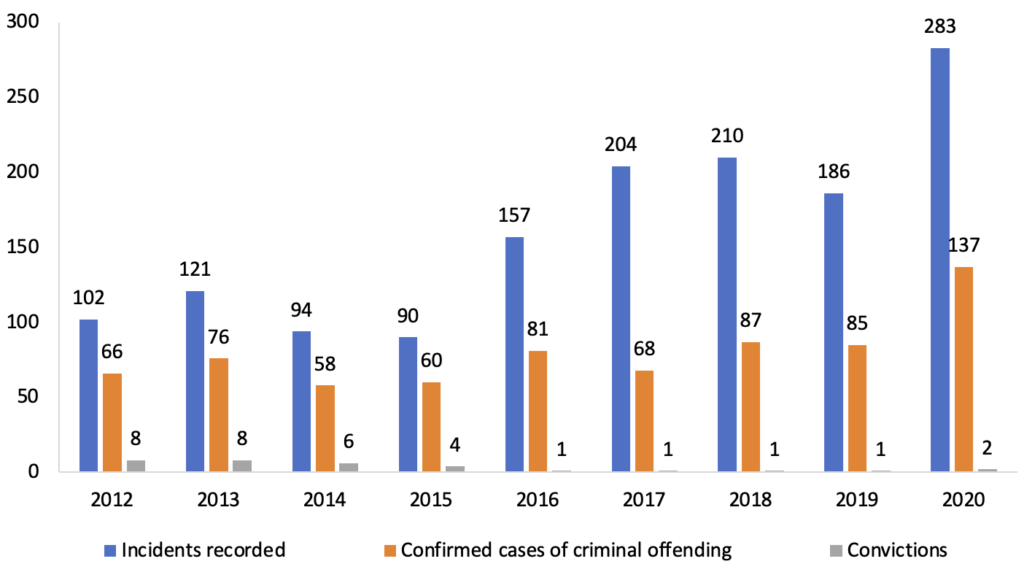
137 of these reports were confirmed to involve a criminal offence against birds of prey, a 52-case increase from 2019 and 64 more cases than the previous eight year average8,17,70,78-81. Many of these reports were made during Covid-19 lockdowns in spring 202068,82, suggesting that there could be a ‘lockdown effect’ impact at play – potentially resulting in more people reporting incidents as they spent more time in the countryside. This seems unlikely given that raptor persecution has been increasing annually and is known to be under-represented in formal data, and because between 2019 and 2020 confirmed cases of persecution in England doubled70. It is unlikely that increases of this size are the result of increases in reports alone; it is much more likely to be a combination of more reporting, and more offences taking place during 2020.
Conclusion
Wildlife crime is a complicated subject, and both the type and availability of information varies greatly depending on what kind of crime is being discussed. Despite that, we can draw some conclusions from the information available.
For amphibians and reptiles, poaching of hare and deer, and marine mammal disturbance – there really is not enough data to say one way or another if more crime took place in 2020 in the UK, even if anecdotal or regional reports say otherwise. However, particularly in the case of poaching crimes, the fact that victim intimidation is a big part of the criminal process makes it unlikely that any increases are because more people reported potential incidents. In the case of crimes against fisheries and raptors, it seems likely that more crimes took place during 2020 given that the number of reported incidents in both cases rose so dramatically. In the case of bat crimes and wildlife trade, it appears that levels of crime were largely limited by the pandemic and Covid-19 restrictions on building works, supply chains, international shipping, and transport – meaning that it is likely that less crime took place, because there simply wasn’t opportunity. Badger crimes, however, seems to be a perfect example of the ‘lockdown effect’, with expert opinion and data suggesting that there was both an increase in crime and an increase in reporting in 2020.
Ultimately, what a lot of this discussion and data goes to show is that some types of wildlife crime likely increased in 2020, and others did not. We do not have enough formal, detailed and long-term information about wildlife crime taking place in the UK despite the best efforts of the police, NGOs, volunteers and ecologists alike, and this is unlikely to change until wildlife crime becomes ‘notifiable’ to the Home Office, in which case reports will be centrally kept by the government, allowing for much better reporting.
Donate and help us fight misinformation
References
- Ebersole, R. (2021). Reports of raptor killings soared during the U.K.’s lockdown. National Geographic: Available at: https://www.nationalgeographic.co.uk/environment-and-conservation/2021/10/reports-of-raptor-killings-soared-during-the-uks-lockdown. (Accessed: 7th February 2022)
- Carrington, D. (2021). Reports of wildlife crime surged in England and Wales in 2020 – survey. The Guardian: Available at: https://www.theguardian.com/environment/2021/nov/25/reports-of-wildlife-surged-in-england-and-wales-in-2020-survey. (Accessed: 11th February 2022)
- Deadline News. (2021). Cops crack down on Scottish wildlife crime as cases double over lockdown. Deadline News: Available at: https://www.deadlinenews.co.uk/2021/09/07/scottish-cops-cracking-down-on-wildlife-crime-as-incident-figures-doubled-over-the-course-of-lockdown-wildlife-news-scotland/. (Accessed: 11th February 2022)
- Hislop, J. (2021). Reports of wildlife crime doubled during lockdown say police. Border Telegraph: Available at: https://www.bordertelegraph.com/news/19562186.reports-wildlife-crime-doubled-lockdown-say-police/. (Accessed: 11th February 2022)
- Gloucestershire Constabulary. (2021). Rural wildlife crime still rising during lockdown. Available at: https://www.gloucestershire.police.uk/news/gloucestershire/rural-wildlife-crime-still-rising-during-lockdown/. (Accessed: 11th February 2022)
- Police Professional. (2021). Reports of wildlife crimes surged during the pandemic. Available at: https://www.policeprofessional.com/news/reports-of-wildlife-crimes-surged-during-the-pandemic/. (Accessed: 11th February 2022)
- Badger Trust. (2021). Crime report reveals a very bad year for badgers with a 36% surge in reported badger crime. Available at: https://www.badgertrust.org.uk/post/crime-report-reveals-a-very-bad-year-for-badgers-with-a-36-surge-in-reported-badger-crime. (Accessed: 4th February 2022)
- Wildlife and Countryside Link & Wales Environment Link. (2021). Wildlife crime in 2020: A report on the scale of wildlife crime in England and Wales. London.
- Police Scotland. Wildlife Crime. Available at: https://www.scotland.police.uk/advice-and-information/wildlife-crime/. (Accessed: 7th February 2022)
- National Wildlife Crime Unit. What is wildlife crime. Available at: https://www.nwcu.police.uk/what-is-wildlife-crime/. (Accessed: 4th February 2022)
- National Wildlife Crime Unit. Current UK priorities. Available at: https://www.nwcu.police.uk/how-do-we-prioritise/priorities/. (Accessed: 14th February 2022)
- United Nations Office on Drugs and Crime. (2021). Wildlife and Forest Crime Analytic Toolkit Report: United Kingdom of Great Britain and Northern Ireland.
- Bat Conservation Trust. (2020). Company handed largest ever fine in relation to a wildlife crime. Available at: https://www.bats.org.uk/news/2020/12/company-handed-largest-ever-fine-in-relation-to-a-bat-crime. (Accessed: 21st February 2022)
- Wildlife and Countryside Link & Wales Environment Link. (2018). Wildlife crime in 2017: A report on the scale of wildlife crime in England and Wales. London.
- Wildlife and Countryside Link & Wales Environment Link. (2017). Wildlife crime in 2016: A report on the scale of wildlife crime in England and Wales. London.
- Wildlife and Countryside Link & Wales Environment Link. (2020). Wildlife crime in 2019: A report on the scale of wildlife crime in England and Wales. London.
- Gosling, J. (2017). The Recording of Wildlife Crime in England and Wales: Reviewing the effectiveness of current practices. London.
- Wildlife and Countryside Link & Wales Environment Link. (2019). Wildlife crime in 2018: A report on the scale of wildlife crime in England and Wales. London.
- North Yorkshire Police. (2018). Wildlife Crime Policing Strategy: Safeguarding our wildlife.
- Casciani, D. & Butcher, B. (2021). Covid: What’s happened to crime during the pandemic? BBC News: Available at: https://www.bbc.co.uk/news/56463680. (Accessed: 14th February 2022)
- Nivette, A.E., Zahnow, R., Aguilar, R., Ahven, A., Amram, S., Ariel, B., Burbano, M.J.A., Astolfi, R., Baier, D., Bark, H.M., Beijers, J.E.H., Bergman, M., Breetzke, G., Concha-Eastman, I.A., Curtis-Ham, S., Davenport, R., Díaz, C., Fleitas, D., Gerell, M., Jang, K.H., Kääriäinen, J., Lappi-Seppälä, T., Lim, W.S., Revilla, R.L., Mazerolle, L., Meško, G., Pereda, N., Peres, M.F.T., Poblete-Cazenave, R., Rose, S., Svensson, R., Trajtenberg, N., van der Lippe, T., Veldkamp, J., Perdomo, C.J.V. & Eisner, M.P. (2021). A global analysis of the impact of COVID-19 stay-at-home restrictions on crime. Nature Human Behaviour, 5:868–877.
- Elkin, M. (2021). Crime in England and Wales. Office for National Statistics: Available at: https://www.ons.gov.uk/peoplepopulationandcommunity/crimeandjustice/bulletins/crimeinenglandandwales/yearendingmarch2021. (Accessed: 15th February 2022)
- Police Scotland. (2021). Quarter 4 Performance: Report January to March 2020/21.
- Amphibian and Reptile Conservation. (2012). Captive Animal and Trade Policy Policy Statement.
- The Amphibian and Reptile Conservation Trust. Bearing Witness for Wildlife. Available at: https://www.arc-trust.org/bearing-witness-for-wildlife. (Accessed: 19th January 2022)
- Wynn-Davies, S. (2020). Warning after grass snake is killed in Hastings Country Park. Hastings and St. Leonards Observer:
- Badger Trust. Stop Badger Crime. Available at: https://www.badgertrust.org.uk/crime. (Accessed: 22nd February 2022)
- Browne, M. & Fellowes, C. (2021). Personal communications, “Wildlife and Countyside Link Report.”
- Bat Conservation Trust. UK Bats. Available at: https://www.bats.org.uk/about-bats/what-are-bats/uk-bats. (Accessed: 25th February 2022)
- Bat Conservation Trust. Bats and the law. Available at: https://www.bats.org.uk/advice/bats-and-the-law. (Accessed: 25th February 2022)
- National Wildlife Crime Unit. First Proceeds of Crime Act order for destroying bat roost. Available at: https://www.nwcu.police.uk/news/nwcu-police-press-releases/first-proceeds-of-crime-act-order-for-destroying-bat-roost/. (Accessed: 20th January 2022)
- Bat Conservation Trust. (2017). Convictions for bat crime at Leamington Spa Magistrates Court. Available at: https://www.bats.org.uk/news/2017/05/convictions-for-bat-crime-at-leamington-spa-magistrates-court. (Accessed: 28th February 2022)
- Bat Conservation Trust. (2020). Bat Crime 2020 .
- Suresh, S., Renukappa, S. & Stride, M. (2020). The impact of Covid-19 on the UK construction industry. Wolverhampton.
- Crimestoppers. Wildlife crime and how it affects rural communities. Available at: https://crimestoppers-uk.org/keeping-safe/rural-crime/wildlife-crime. (Accessed: 10th February 2022)
- The British Association for Shooting & Conservation. (2020). Poaching of Game, Deer and Fish.
- Cassidy, M. (2021). Warning to poachers after police find four deer shot dead. Chronicle Live: Available at: https://www.chroniclelive.co.uk/news/north-east-news/warning-poachers-after-police-find-21368742. (Accessed: 2nd March 2022)
- Khan, S. (2022). Police search for poachers after deer shot and disembowelled. Lancashire Telegraph: Available at: https://www.lancashiretelegraph.co.uk/news/19956509.police-search-poachers-deer-shot-disembowelled/. (Accessed: 2nd March 2022)
- Cunnington, P. (2021). Lancashire police operation cracks down on deer poaching in county beauty spot. Lancashire Evening Post: Available at: https://www.lep.co.uk/news/crime/lancashire-police-operation-cracks-down-on-deer-poaching-in-county-beauty-spot-3505613. (Accessed: 2nd March 2022)
- Farnworth, A. (2021). Warning not to buy meat from poachers after deer carcass found on Burnley footpath. Lancashire Telegraph: Available at: https://www.lancashiretelegraph.co.uk/news/19718661.warning-not-buy-meat-poachers-deer-carcass-found-burnley-footpath/. (Accessed: 2nd March 2022)
- Moore, C. (2021). Lockdown has made poachers bolder – and more dangerous. The Spectator: Available at: https://www.spectator.co.uk/article/lockdown-has-made-poachers-bolder–and-more-dangerous. (Accessed: 2nd March 2022)
- Ash, J. (2021). Police crack down on poaching across Derbyshire. Derbyshire Live: Available at: https://www.derbytelegraph.co.uk/news/police-crack-down-poaching-across-6024845. (Accessed: 2nd March 2022)
- ITV News Anglia. (2021). Hare coursers by day, deer poachers by night: the battle to catch the culprits continues. Available at: https://www.itv.com/news/anglia/2021-03-17/hare-coursers-by-day-deer-poachers-by-night-the-battle-to-catch-the-culprits-continues. (Accessed: 2nd March 2022)
- Goodall, O. (2021). The Reality of Rural Crime: The Unintended Consequences of Rural Policy in the Co-Production of Badger Persecution and the Illegal Taking of Deer. British Journal of Criminology, 61:1005–1025.
- Bowcott, O. (2008). Illegal slaughter that may claim 50,000 deer a year. The Guardian: Available at: https://www.theguardian.com/environment/2008/mar/22/wildlife.conservation. (Accessed: 2nd March 2022)
- The British Deer Society. Poaching and Wildlife Crime. Available at: https://www.bds.org.uk/information-advice/issues-with-deer/poaching-and-wildlife-crime/. (Accessed: 9th February 2022)
- Tobe, S.S., Govan, J. & Welch, L.A. (2011). Tackling poaching: Recovery of human DNA profiles from deer remains. Forensic Science International: Genetics Supplement Series, 3:e265–e266.
- Wyatt, T. (2016). Victimless venison? Deer poaching and black market meat in the UK. Contemporary Justice Review, 19:188–200.
- UK Government. (2022). New legislation to crack down on cruel illegal hare coursing. Available at: https://www.gov.uk/government/news/new-legislation-to-crack-down-on-cruel-illegal-hare-coursing. (Accessed: 7th February 2022)
- Poaching Priority Delivery Group. (2019). Poaching Priority Delivery Group Newsletter: 4th Edition – Winter 2018/19.
- National Farmers’ Union & National Farmers’ Union Cymru. Combatting Rural Crime.
- Beever, S. (2020). Criminal gangs still travelling to rural Yorkshire for illegal hare coursing as calls made for tougher penalties for the bloodsport. The Yorkshire Post:
- Nellemann, C., Henriksen, R., Kreilhuber, A., Stewart, D., Kotsovou, M., Raxter, P., Mrema, E. & Barrat, S. (2016). The Rise of Environmental Crime – A Growing Threat To Natural Resources Peace, Development And Security. A UNEP-INTERPOL Rapid Response Assessment. The Rise of Environmental Crime: doi:10.18356/cdadb0eb-en
- HM Government. (2018). A Green Future: Our 25 Year Plan to Improve the Environment. London.
- WWF. (2016). Sentencing Wildlife Trade Offences in England and Wales: Consistency, Appropriateness, And The Role Of Sentencing Guidelines.
- Fukushima, C.S., Mammola, S. & Cardoso, P. (2020). Global wildlife trade permeates the Tree of Life. Biological Conservation, 247:
- Felbab-Brown, V. (2020). What coronavirus means for online fraud, forced sex, drug smuggling, and wildlife trafficking. Brookings: Available at: https://www.brookings.edu/blog/order-from-chaos/2020/04/03/what-coronavirus-means-for-online-fraud-forced-sex-drug-smuggling-and-wildlife-trafficking/. (Accessed: 14th February 2022)
- Kirkpatrick, C. (2021). USAID Wildlife Asia Counter Wildlife Trafficking Digest: Southeast Asia and China, 2020.
- Abano, I. & Chavez, L. (2021). Wildlife trafficking, like everything else, has gone online during COVID-19. Mongabay News: Available at: https://news.mongabay.com/2021/06/wildlife-trafficking-like-everything-else-has-gone-online-during-covid-19/. (Accessed: 14th February 2022)
- Matthews, A. (2020). The wild animals at risk in lockdown. BBC Future: Available at: https://www.bbc.com/future/article/20200520-the-link-between-animals-and-covid-19. (Accessed: 14th February 2022)
- The Mammal Society. UK Mammal List. Available at: https://www.mammal.org.uk/species-hub/uk-mammal-list/. (Accessed: 3rd March 2022)
- Bellman, K., Bennett, S., James-Hussey, A., Watson, L., Ottaway, A. & Sayer, S. (2019). The growing threat of seal disturbance in the United Kingdom: Case studies from around the British coast. Cornwall.
- Cornwall Wildlife Trust. (2021). Marine disturbance in Cornwall triples in six years. Available at: https://www.cornwallwildlifetrust.org.uk/news/marine-disturbance-cornwall-triples-six-years. (Accessed: 3rd March 2022)
- Chapman, A. (2021). How the pandemic has changed holidaymaking in Britain. The Conversation: Available at: https://theconversation.com/how-the-pandemic-has-changed-holidaymaking-in-britain-168409. (Accessed: 3rd March 2022)
- Murgatroyd, M., Redpath, S.M., Murphy, S.G., Douglas, D.J.T., Saunders, R. & Amar, A. (2019). Patterns of satellite tagged hen harrier disappearances suggest widespread illegal killing on British grouse moors. Nature Communications, 10:
- Whitfield, D.P. & Fielding, A.H.A. (2017). Analyses of the Fates of Satellite Tracked Golden Eagles in Scotland. Commissioned Report 982. Inverness, Scotland.Kaczensky, P., Ito, T.Y. & Walzer, C.S. (2010). Satellite telemetry of large mammals in Mongolia: What expectations should we have for collar function? Wildlife Biology In Practice, 6:108–126.
- RSPB. Birdcrime 2020.
- What the Science Says. (2020). Are hen harriers illegally killed on English grouse moors? Available at: https://www.whatthesciencesays.org/are-hen-harriers-illegally-killed-on-english-grouse-moors/. (Accessed: 3rd March 2022)
- RSPB. (2020). Birdcrime 2020 Appendices: Data Summary.
- Natural England. (2019). Study suggesting widespread illegal killing of hen harriers on English grouse moors published. Available at: https://www.gov.uk/government/news/study-suggesting-widespread-illegal-killing-of-hen-harriers-on-english-grouse-moors-published. (Accessed: 10th February 2022)
- Klaassen, R., Hake, M., Strandberg, R., Koks, B.J., Trierweiler, C., Exo, K.-M., Bairlein, F. & Alerstam, T. (2014). When and where does mortality occur in migratory birds? Direct evidence from long-term satellite tracking of raptors. Journal of Animal Ecology, 83:176–184.
- Etheridge, B., Summers, R.W. & Green, R.E. (1997). The effects of illegal killing and destruction of nests by humans on the population dynamics of the hen harrier Circus cyaneus in Scotland. Journal of Applied Ecology, 34:1081–1105.
- Redpath, S., Amar, A., Madders, M., Leckie, F. & Thirgood, S. (2002). Hen harrier foraging success in relation to land use in Scotland. Animal Conservation, 5:113–118.
- Whitfield, D.P. & Madders, M. (2006). A Review of the Impacts of Wind Farms on Hen Harriers Circus Cyaneus and an Estimation of Collision Avoidance Rates: Natural Research Information Note 1 (Revised).
- Whitfield, D.P., Fielding, A.H., Mcleod, D.R.A. & Haworth, P.F. (2004). Modelling the effects of persecution on the population dynamics of golden eagles in Scotland. Biological Conservation, 119:319–333.
- Amar, A., Court, I.R., Davison, M., Downing, S., Grimshaw, T., Pickford, T. & Raw, D. (2012). Linking nest histories, remotely sensed land use data and wildlife crime records to explore the impact of grouse moor management on peregrine falcon populations. Biological Conservation, 145:86–94.
- RSPB. (2019). Birdcrime 2019 Appendices: Data Summary.
- RSPB. (2016). Birdcrime 2016 Appendices: Data Summary.
- RSPB. (2017). Birdcrime 2017 Appendices: Data Summary.
- RSPB. (2018). Birdcrime 2018 Appendices: Data Summary.
- RSPB. Birdcrime 2019. Available at: https://rspb.org.uk/birds-and-wildlife/advice/wildlife-and-the-law/wild-bird-crime/birdcrime-report-2019/. (Accessed: 10th February 2022)